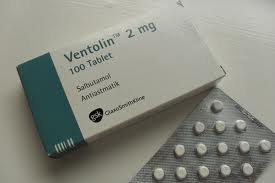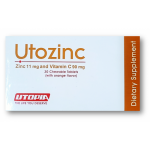
Ventolin
oral prepartion salbutamol
PRESENTATION:
VENTOLlNTablets 2 mg each contain 2 mg salbutamol, as sulphate,
VENTOLlN Syrup contains 2 mg satbutamcl as sulphate in each 5 rnl of syrup.
Indications :
VENTOUN is a selective P2 adrenoceptor agonist. At therapeutic doses it acts on the P2 adrenoceptors of bronchial muscle, with little or no action on the P-l adrenoceptors of the heart It is suitable for the management and prevention of attack in asthma. BronchodHators should not be the only or main treatment in patients with severe or unstable asthma. Severe asthma requires regular medical assessment as death may
Patients with severe’asttnna have cnnstannymptoms and ffequent exacerbation$, WI
limited physical capacity, and PEF values below 60% predicted at baseline with greater than 30% variability, usually not returning entirely to normal after a bronchodilator. These patients will require high dose inhaled (e.g > 1 mg/day bectomethasone dipropionate) or oral corticosteroid therapy. Sudden worsening of symptoms may require increased corticosteroid dosage which should be administered under urgent medical supervision. Relief of bronchospasm in bronchial asthma of all types, chronic bronchitis and emphysema. The management of uncomplicated premature labour during the third trimester of pregnancy following the control of uterine contractions with parenteral VENTOLlN.
Dosage and Administration :
VENTOLlN has a duration of action of 4 to 6 hours in most patients. Increasing use of 132 agonists may be e sign of worsening asthma. Under these Condittons-a reassessment of the patient’s therapy plan may be required and concomitant glucocorticosteroid therapy should be considered. As there may be adverse effects associated with excessive dosing, the dosage or frequency of administration should only be increased on medical advice.
– Adults
The usual effective dose is 4 milligrams three or four times per day. If adequate bronchodilation is not obtained each single dose may be gradually increased to as much as 8 milligrams. Some patients obtain adequate relief with 2 milligrams three or four times daily. In the management of premature labour, after uterine contractions have been controlled by intravenous infusion of VENTOLlN and the infusion has been withdrawn, maintenance therapy ran be continued With oJal VENTOLlN. The usual dosage is 4 mill! rams. three or fou time aai’V .
– Children
2 – 6 years 1 to 2 milligrams
6 – 12 years 2 mg (1 tablet of 2 milligrams) three or four times daily. (5 ml syrup)
Over 12 year 2 – 4 milligrams (1 tablet of 2 milligrams) three or four times daily.
– Special patient groups
In elderly patients or in those known to be unusually sensitive to ~-adrenergic stimulant drugs, it is advisable to initiate treatment with 2 milligrams salbutamol three or four times per day.
Contra indications :
VENTOUN Tablets are contraindicated in patients with a history of hypersensitivity to any of their components. Although intravenous VENTOLlN and occasionally VENTOlIN tablets are used in the management of premature labour uncomplicated by conditions such as placenta praevia, ante-partum haemorrhage or toxaemia of pregnancy, VENTOLlN presentations should not be used for threatened abortion.
Warnings and Precautions:
The management of asthma should normally follow a stepwise programme, and patient response should be monitored clinically and by lung function tests.
Increasing use of short-acting inhaled ~2 agonists to control symptoms indicates
deterioration of asthma control. Under these conditions, the patient’s therapy plan should be reassessed. Sudden and progressive deterioration in asthma control is potentially life- threatening and consideration should be given to starting or increasing corticosteroid therapy. In patients considered at risk, daily peak flow monitoring may be instituted. Patients should be warned that if either the usual relief is diminished or the usual duration of action reduced, they should not increase the dose or its frequency of administration, but should seek medical advice.
VENTOUN should be administered cautiously to patients with thyrotoxicosis.
Potentially serious hypokalaemia may result from ~2 agonist therapy mainly from
parenteral and nebulised administration. Particular caution is advised in acute severe
asthma as this effect may be potentiated by concomitant treatment with xanthine
derivatives, steroids, diuretics and by hypoxia. It is recommended that serum potassium levels are monitored in such situations. In common with other -adrenoceptor agonists, VENTOLlN can induce reversible metabolic
changes, for example increased blood sugar levels. The diabetic patient may be unable to given to fluid balance and cardia-respiratory function, including ECG should be monitored. If signs of pulmonary oedema or myocardial ischaemia develop, discontinuation of treatment should be considered.
Interactions :
VENTOLlN and non-selective blocking drugs. such as propranolol, should not usually be prescribed together.
VENJOUN is not contraindicated in patients under treatment with monoamine oxida
Pregnancy and lactation :
Administration of drugs during pregnancy should only be considered if the expected benefit to the mother is greater than any possible risk to the foetus. During worldwide marketing experience. rare cases of various congenital anomalies, including cleft palate and limb defects have been reported in the offspring of patients being treated with salbutamol. Some of the mothers were taking multiple medications during their pregnancies. Because no consistent pattern of defects can be discerned, and
baseline rate for congenital anomalies is 2-3%, a relationship with salbutamol use cannot be established. As salbutamol is probably secreted in breast milk its use in nursing mothers is not recommended unless the expected benefits outweigh any potential riskIt is not known whether salbutamol in breast milk has a harmful effect on the neonate.
Effects on Ability to Drive and Use Machines :
None reported
Adverse Reactions :
Adverse events are listed below by system organ class and frequency. Frequencies are
defined as: very common (>: 1/10), common (>: 1/100 and <1/10), uncommon (>: 1/1000 and <1/1(0), rare (>: 1/10,000 and <1/1(00) and very rare «1/10,000) including isolated reports. Very common and common events were generally determined from clinical trial data. Rare and very rare events were generally determined from spontaneous data.
Immune system disorders :
Very rare: Hypersensitivity reactions including angioe erna, urticaria, bronchospasm,
hypotension and collapse.
Metabolism and nutrition disorders :
Rare: Hypokalaemia.
Potentially serious hypokalaemia may result from beta2 agonist therapy.
Nervous system disorders :
Very common: Tremor.
Common: Headache.
Very rare: Hyperactivity.
Cardiac disorders :
Common: Tachycardia, palpitations.
rare: an rdtrsysro es irldujng atrial fibrillation,.su.Q[aventricuJar tachycardia
Vascular disorders :
Rare: Peripheral vasodilatation.
Musculoskeletal and connective tissue disorders :
Common: Muscle cramps.
Very rare: Feeling of muscle tension.
Overdose :
The preferred antidote for overdosage with VENTOLlN is a cardioselective blocking agent. However blocking drugs should be used with caution in patients with a history of bronchospasm. Hypokalaemia may occur following overdose with VENTOLlN. Serum potassium levels should be monitored.
Pharmacodynamics :
Salbutamol is a selective ~2 adrenoceptor agonist. At therapeutic doses it acts on the 132 adrenoceptors of bronchial muscle, with little or no action on the 13-1 adrenoceptors of cardiac muscle. administered salbutamol is about 50%.
Store below 25°C protect from light for syrup Et below 30 for tablets
Manufactured by:
GlaxoSmithKline SAE. El Salam City- Cairo- A.R.E.
Under license from The GlaxoSmithKline group of companies

